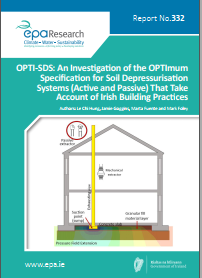Research 332: An Investigation of the Optimum Specification for Soil Depressurisation Systems (Active and Passive) That Take Account of Irish Building Practices
Authors: Le Chi Hung, Jamie Goggins, Marta Fuente and Mark Foley
Summary: In Ireland, Radon is the second biggest cause of lung cancer and it is estimated that 9% of homes exceed the reference level of Radon. Studies in other countries have indicated that the effectiveness of passive sumps is enhanced by sealing across the base of the building. This project examines the characterisation of the T1 Struc and T2 Perm specified granular fill materials for soil depressurisation systems for buildings.

Project Highlights
Watch the OPTI-SDS project highlights video
Identifying Pressures
In Ireland, radon is the second most important cause of lung cancer (after smoking) and is linked to up to 300 cases per year. It is estimated that some 9% of homes exceed the reference level of radon of 200 Bq/m3 and about one-third of the country is categorised as being at high risk.
The National Radon Control Strategy (NRCS) for Ireland identified several knowledge gaps, including the optimum specifications for soil depressurisation (SD) systems (active and passive) that take account of Irish building practices. Few publications exist on this issue in the Irish context and this limits policy development and implementation, as well as hindering the use of novel technologies in the development of “radon-safe” new buildings. Studies in other countries have indicated that the effectiveness of passive sumps is enhanced by appropriate sealing across the base of the building (passive SD systems). Therefore, research is required in this field to take account of Irish building
Practices.
Informing Policy
Radon research has the potential to reduce the radiation burden to the population and hence reduce lung cancer rates. The European Radon Association (ERA) is attempting to consolidate international research efforts, most recently at the ERA meeting in February 2020 in Vienna. European Union partnerships have been established, with networks including universities, government agencies, and small and medium-sized enterprises, and the outcomes of these will inform international policies. Specific guidance on radon prevention measures for new homes in Ireland is contained in the “Building Regulations 1997, Technical Guidance Document C: Site Preparation and Resistance to Moisture”. The NRCS was developed to address the long-term radon exposure risk and highlights the need to strengthen technical guidance to protect against and prevent radon exposure in new buildings. The OPTI-SDS project findings will inform the NRCS co-ordination groups’ input into the revision of Technical Guidance Document C.
Developing Solutions
The OPTI-SDS project examined the characterisation of the T1 Struc and T2 Perm specified granular fill materials for SD systems for buildings. The project was divided into two experimental test phases. Furthermore, passive depressurisation tests were carried out to examine the performance of different common chimney cowls available on the market for use in passive depressurisation systems.
Computational fluid dynamic simulations were developed and validated to simulate the flow behaviour of the T1 Struc and T2 Perm materials. The key parameters for simulating the flow behaviour of the materials were confirmed to be air permeability, porosity and effective particle diameter. Benchmark input parameters for the design of the T1 Struc and T2 Perm materials are provided in this study.
Finally, a case study was conducted in a pilot house with high radon levels in Spain to examine the ability and efficiency of active and passive SD systems to mitigate radon levels. Radon concentration and pressure field extension under the slab were monitored to examine radon reductions as a function of depressurisation.
https://www.epa.ie/media/archive/research/research-thumbnails/Thumbnail_332.png